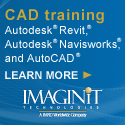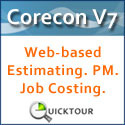
|
www.agc.org Contact Us Archives/Subscribe Advertise IT Forum IT Forum Steering Committee |
Moving Toward Data Integration and Standards in Construction TechnologyWhy integration is key to improving your information’s value and what you do with it
By Maxime Montreuil
Colas Inc.
At Colas Inc., we have a motto when it comes to adding any new information system to our enterprise: The information must be entered only once, by the best person to do so and available to all who need it in real time. As such, integration is at the core of how we envision our systems and is an important task our IT team works on continuously.
"Who cares about integration? I’d rather pay a clerk to enter data than a superintendent" was the typical reply I got when explaining what we were trying to achieve. "My people on the field cannot enter data correctly" is another recurring comment.
Both are valid points, but neither should deter you from considering systems integration if you are looking at the big picture. Integration encompasses both internal (within the company) and external (owners, architects, subcontractors) information exchanges and generates a lot of added value for any company, including:
1. Avoiding data re-keying, which can be summed up in two benefits:
2. Reducing cycle times before the information contained in the data is available for all the enterprise to digest, interpret and act upon. Once the data is approved, it can be very quickly replicated to wherever is required in a matter of minutes, as opposed to a set of asynchronous manual processes ran by different people with different schedules which can take days. Providing the information to decision makers more quickly can allow them to make decisions earlier.
3. Integrating more closely with your partners in the construction supply chain, from owners down to suppliers. Wouldn’t you want to be able to exchange information between your systems and your partner’s without having to care about what system he is using? This would allow you, for example, to better manage the scope and content of a project by having detailed information about each small parts of it, even if you are not doing all the work yourself. BIM alleviates some of this, but what about the rest of the information? The owner/contractor agreements, schedules of values, requests for information (RFIs), requests for proposals (RFPs), architect/engineer supplemental instructions, change orders, change directives, submittals, applications for payment, and addenda, to name a few.
Integration doesn’t mean you should forego data control in most cases. You will still need the person who knows best to review, validate and correct transactional data before it makes its way to all the systems where it is needed. Integration doesn’t replace people’s added cognitive value; it gets the information flowing between systems more fluid and accurate. Without integration, you fall back under the "garbage in / garbage out" conundrum used by your IT people. You may have the best information system in the world, but if the data fed into it is incorrect you will not get any benefit from it. Computers cannot turn nonsensical information into a gold mine magically. At least, not yet.
That being said, integration is hard and complicated. Which means it is costly, sometimes prohibitively so, for smaller companies. It explains why for most companies integration is synonymous to "massaging data in excel." But this approach will only get you so far.
Today, there are not any standards that define data formats for our industry, nor is there an agreed-upon data transport technology used by all our software providers. Most vendors are likely to have already integrated with the other major players, but it is usually a specific point-to-point custom development that needs to be partially redeveloped for each customer. There are multiple options existing, and the customer usually ends up having to support and maintain a set of technology stacks to make their integration work. By agreeing on a standard "language" on how information is conveyed, we can alleviate some of the complexity and costs.
The agcXML initiative aims to define standard information structures to exchange data between systems and is partnering with other groups, working on the rest of the layers of the integration problem (e.g., data storage and transport, security). Our industry has not spent as much time on information integration standards as other industries already have, but the need to have better information is universal. Better information leads to better decisions. The agcXML initiative is not new; it was started in 2004. The effort has been renewed this year to get it to the next level and get adoption around it. AGC is continuing to lead the way toward a more efficient and productive future for our industry with this initiative.
The beneficiaries of such a standard, once embraced by the community, are all E&C companies, no matter their size. Benefits of standards include:
At the end of the day, picking a new solution should be more like playing with Lego blocks: You should be able to pick the best fitting block, in regard to your overall strategy, and just interconnect it to the other ones without having to redesign the whole concept of a Lego block for it.
I, for one, cannot wait to see this day come upon us. For over 11 years, Maxime has worked for Colas, first in France, as an integration project manager attached to the local IT department. In the last five years, Maxime has worked in the U.S. at Colas IS Support. As IT Director for Colas, Maxime manages the structure in charge of all IT infrastructure and information systems shared by its subsidiaries. Maxime holds a masters in computer science from a French school, as well as a masters in management of information systems from the Stevens Institute of Technology (NJ). He lives in the greater Denver area, Colo/, with his spouse and two young daughters. |

2300 Wilson Boulevard, Suite 300 · Arlington, VA 22201 · 703-548-3118 (phone) · 703-548-3119 (fax) · www.agc.org
About AGC | Advocacy | Industry Topics | Programs and Events | Career Development | News & Media
© Copyright 2025 The Associated General Contractors of America. All rights reserved.


